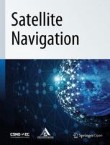Satellite Navigation is the official journal of the Aerospace Information Research Institute.
Subcarrier modulated navigation signal processing in GNSS: a review
Subcarrier modulated signals are widely used in the new generation of Global Navigation Satellite Systems (GNSS) to improve spectral compatibility and ranging accuracy. The unique structure of subcarrier modul...
